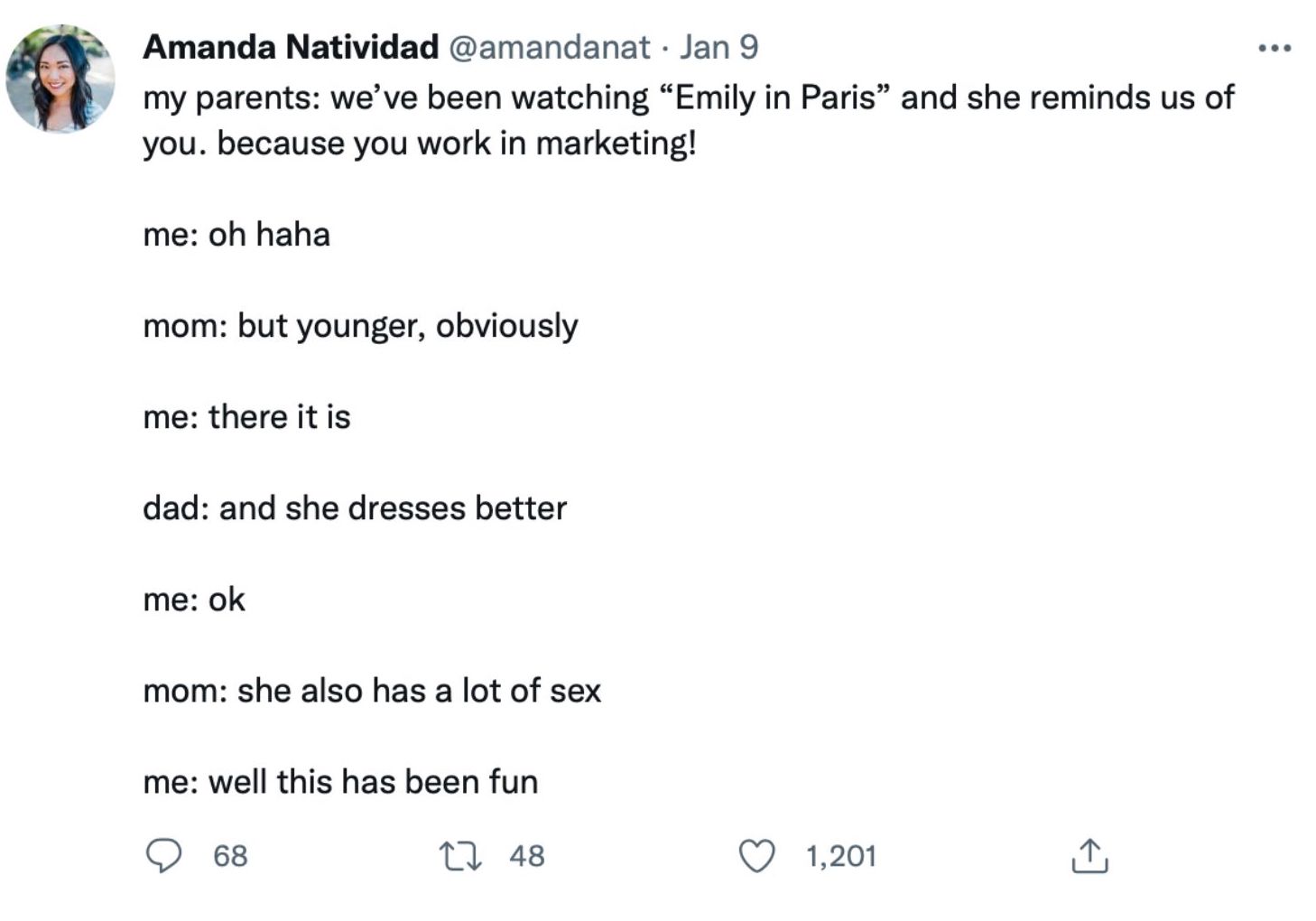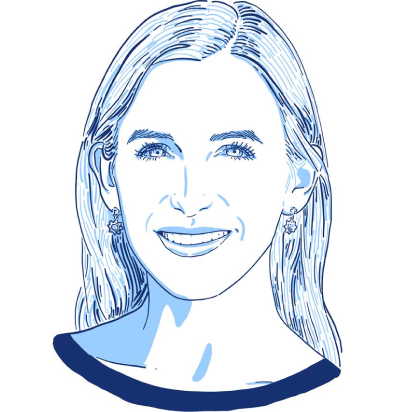Amanda Natividad grew her Twitter following from 1k to 60k in a year. It now has over 100k followers. She has another 12k followers on LinkedIn and 5k subscribers to her newsletter The Menu, which she launched in 2021. We asked her how she did it.
Amanda Natividad knows how to go viral.
14k reactions and 1.1 million impressions on LinkedIn.
3k+ likes on Twitter. Her Twitter threads regularly get 4-10k+ likes.
It’s not surprising that she understands virality. People with massive online followings are generally pretty good at that.
But she also knows something that’s much harder: how not to go viral. If a thread is all but guaranteed to get thousands of likes, but it runs the risk of turning her into “that person who tweets about that thing,” and that thing isn’t what she wants to be known for, she won’t tweet about it.
She also won’t post anything that could hurt her credibility among her community, that won’t be genuinely useful to her readers, or that doesn’t align with her beliefs and goals.
Put another way: She knows how to choose value over virality.
Which, counterintuitively, is how she’s managed to grow her following in a digital landscape that’s noisier than a Meat Loaf album.
In choosing value over virality, she’s built an audience that comes to her for precisely the insights she offers. Case in point: When she tweeted the waitlist for her Content Marketing 201 course, 300 people signed up in two days.
It’s possible that her audience would be bigger if she were posting about “25 things you didn’t know you could do in x platform,” to use an example she gives. But it wouldn’t be the audience she can build the strongest affinity with. And it probably wouldn’t include a former president.
We talked to Amanda about her audience-building story and the tactics she recommends. Value is central to all of them.
Here are five takeaways.
1. Know what you want to get out of audience building
You wouldn’t learn how to sail if you didn’t plan to go sailing. You wouldn’t give a speech if you didn’t have a message to share.
If you’re trying to build an audience, it helps to know why you’re doing it.
Amanda was working for Growth Machine, the SEO content agency founded by Nat Eliason, when she first started building an online presence in 2020. She’d been in marketing for about eight years—after earlier careers in tech journalism and the culinary arts—but she hadn’t done much online posting.
“It just never occurred to me,” she told us. “Not only did it not occur to me to build an audience, I just felt like, I don’t want to do that. I can’t do that. I’m not qualified.”
Nat made it clear that she was qualified. (“Having someone who believed in me, who had his own following, his own clout, that was kind of groundbreaking for me,” she said.) And it would be good for business if she were to start posting about marketing.
So her first goal was external: grow the brand she was working for. In the process, she could aim to become better known in her field of content marketing.
She began doing the work of learning what to do. She took David Perell’s Write of Passage course, which gave her the courage to write longer-form online content.
Then she took Demand Curve’s audience-building course, where she learned to step outside her comfort zone and apply direct-response copywriting best practices to her content. (We’ll discuss those best practices at Step 3.) And she learned a repeatable workflow for writing and publishing effective tweets.
In learning from and meeting intellectual peers in these courses, Amanda honed her online writing skills and found serendipitous professional opportunities that opened up her network.
She realized that posting online could be a way to chart her own career path. She walked away from those experiences with a new goal: to grow her career without ever having to do a traditional job search again.
“I was still posting about my work, posting about marketing strategy and content strategy, but I did it with a little more of the intrinsic motivation of, I don’t ever want to do a traditional job hunt,” she said.
It worked. She had been following SparkToro co-founder Rand Fishkin on Twitter, and one day, he followed her back. That led to an in-person lunch—and, eventually, her current job as SparkToro’s VP of marketing.
What do you do when you meet your goal?
Amanda succeeded at avoiding the traditional job hunt. She met her goal.
So what’s next?
Goals, like everything else that still exists, evolve. She’s thinking through her next one, but it could be increasing monetization. She’s recently started to feature sponsors in her newsletter, The Menu.
But she’ll only pursue monetization opportunities if they reflect her values. That means no partnerships with brands whose business model she doesn’t agree with. Some have approached her; she’s turned them down.
It also means thinking through how monetization supports her values of inclusivity, accessibility, and opening up doors for others.
“I don’t know that there are a lot of women monetizing through sponsorships. So there’s a part of me that makes me want to dive deeper into that, so that I can be an example for other women who want to do this too.”
Goal takeaways
- Be the Nat to someone’s Amanda. If you spot talent, support and nurture it.
- In our audience-building class, we recommend having a specific, time-bound, measurable goal (e.g., “get to 5k followers by November”). But goals can take many shapes, and not all are numerical or time-sensitive. Something like “get a job without going the traditional application route” can be just as useful.
- Adjust your goals as either 1) you meet them, or 2) they stop serving you.
- Your reputation is priceless. Avoid aligning yourself with brands you don’t respect.
2. Pick a lane. Stick with it until you’re ready to explore a little.
Amanda’s early social presence was all about content and marketing.
She’d defined her goals—brand building, then career building—and she could use those goals to guide her content strategy. Her niche was clear: She’d post about what she knew about marketing.
“I was realizing that people who are growing their accounts fastest were the people who stuck to their niche,” she told us. “So the first priority was getting to a good, healthy path of growth.”
For the first six to 10 months, that’s exactly what she did.
She still writes about marketing—about 80% of the time. Once she reached a critical mass of about 15-20k followers around the 10-month mark, she decided to venture beyond those marketing parameters every now and then.
“The fun stuff is still rooted in some kind of value,” Amanda said. “I won’t post, ‘Oh, I love coffee, I’m having coffee for breakfast!’ It might be about food, but it’ll be a recipe or thread of recipes, which are valuable in some way to some people. … Or if I think something is genuinely funny from my daily life, I’ll share that—the value being entertainment.”
“The niche content still gets the highest engagement and shows my expertise in marketing. But the fun posts are mostly for myself, to laugh with friends on the timeline and help stave off burnout.”
Another reason to explore beyond your niche: affinity building. Amanda’s non-marketing content highlights that, although she’s one of the top marketers working today, she’s also relatable and vulnerable, with plenty of interests outside of work. That builds even stronger connections with her readers.
If you’re going to head in new directions, think about how they relate to your niche. Veer off course to keep content lively and connections strong. But don’t veer so far that you’ll confuse or alienate people.
- If you’re in sales, your life isn’t 100% sales. What are some topics you’d talk about in the break room? What are your thoughts on business decisions or product roadmaps—things that affect your work but don’t define it?
- If you write about a specific topic (say, body positivity), consider all the arenas it’s related to, from social implications to pop culture.
Niche takeaways
- You need a topic: the thing that people follow you for because they want your take on it. Stick with it until you’ve reached a certain critical mass. At that point, it’s okay to get a little exploratory.
- Twitter has changed in countless ways since 2006, but one thing holds true: No one cares, or has ever cared, about what you ate for breakfast.















